Sociology Assignment: Egalitarian Society - Australia's Case Study
VerifiedAdded on 2019/10/30
|6
|1192
|88
Essay
AI Summary
This sociology assignment delves into the concept of an egalitarian society, defining it as a social construct devoid of inequality and discrimination. The paper examines the Marxian perspective on egalitarianism, emphasizing the need for revolution to establish a communist structure. The assignment then focuses on Australia, often considered a promoter of egalitarianism, highlighting its efforts in reducing discrimination, increasing education, and improving economic prosperity. However, the assignment also identifies drawbacks, such as challenges to welfare, unemployment, geographical disparities, and a dualistic trend in education and health. The conclusion recommends increasing social mobility and designing policies to expand people's capacities and equal distribution of facilities to regain Australia's egalitarian status. The paper includes references to support its arguments.
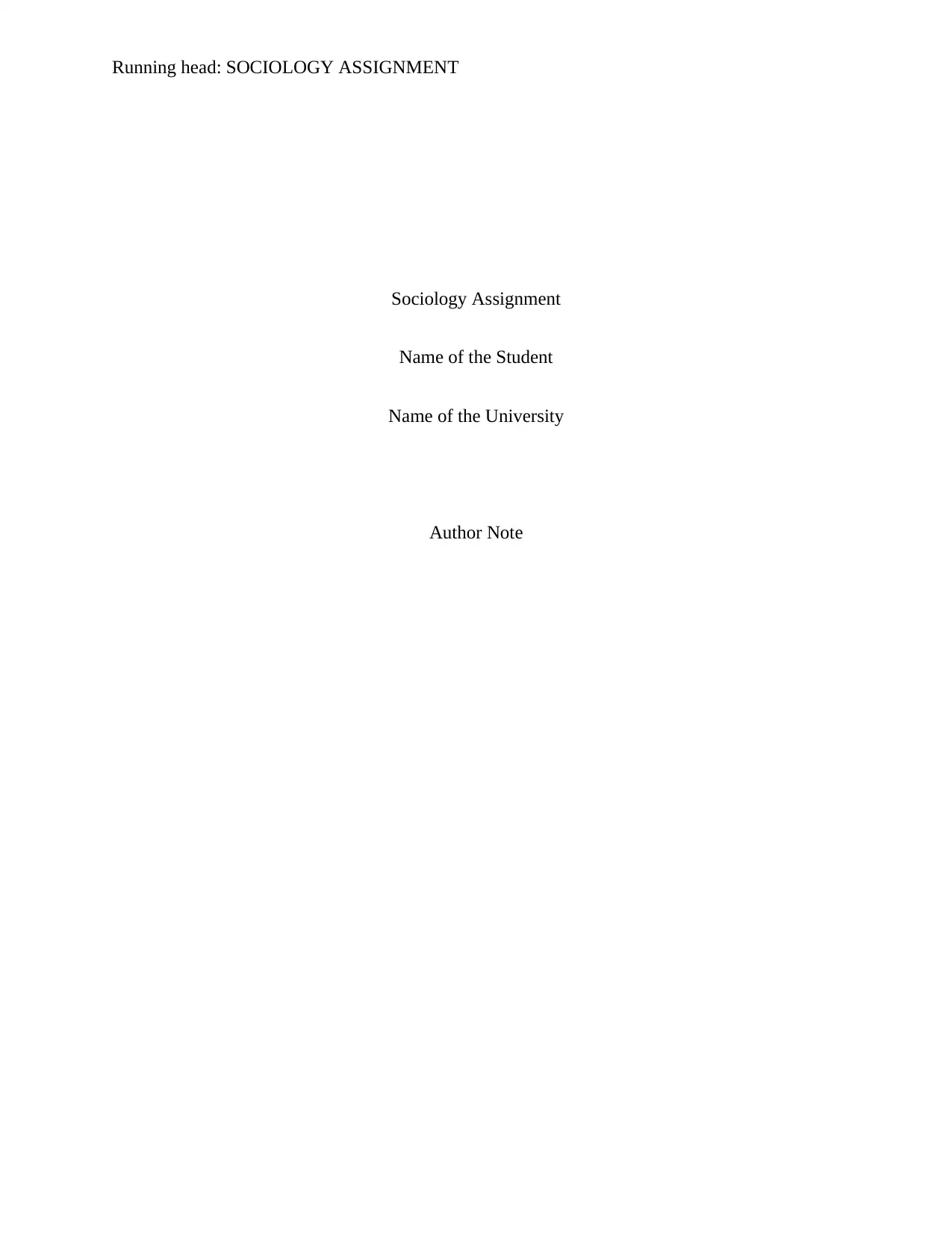
Running head: SOCIOLOGY ASSIGNMENT
Sociology Assignment
Name of the Student
Name of the University
Author Note
Sociology Assignment
Name of the Student
Name of the University
Author Note
Paraphrase This Document
Need a fresh take? Get an instant paraphrase of this document with our AI Paraphraser
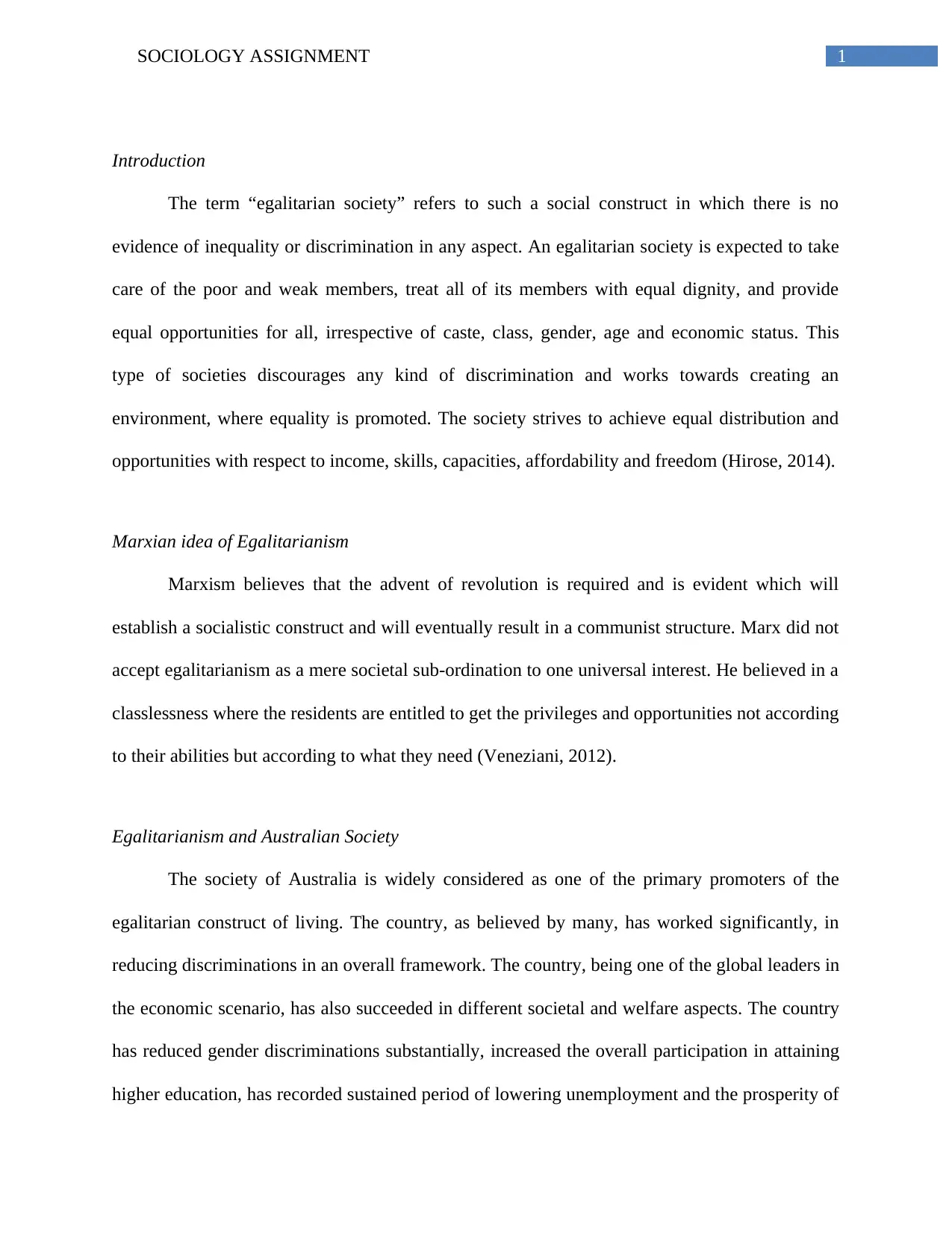
1SOCIOLOGY ASSIGNMENT
Introduction
The term “egalitarian society” refers to such a social construct in which there is no
evidence of inequality or discrimination in any aspect. An egalitarian society is expected to take
care of the poor and weak members, treat all of its members with equal dignity, and provide
equal opportunities for all, irrespective of caste, class, gender, age and economic status. This
type of societies discourages any kind of discrimination and works towards creating an
environment, where equality is promoted. The society strives to achieve equal distribution and
opportunities with respect to income, skills, capacities, affordability and freedom (Hirose, 2014).
Marxian idea of Egalitarianism
Marxism believes that the advent of revolution is required and is evident which will
establish a socialistic construct and will eventually result in a communist structure. Marx did not
accept egalitarianism as a mere societal sub-ordination to one universal interest. He believed in a
classlessness where the residents are entitled to get the privileges and opportunities not according
to their abilities but according to what they need (Veneziani, 2012).
Egalitarianism and Australian Society
The society of Australia is widely considered as one of the primary promoters of the
egalitarian construct of living. The country, as believed by many, has worked significantly, in
reducing discriminations in an overall framework. The country, being one of the global leaders in
the economic scenario, has also succeeded in different societal and welfare aspects. The country
has reduced gender discriminations substantially, increased the overall participation in attaining
higher education, has recorded sustained period of lowering unemployment and the prosperity of
Introduction
The term “egalitarian society” refers to such a social construct in which there is no
evidence of inequality or discrimination in any aspect. An egalitarian society is expected to take
care of the poor and weak members, treat all of its members with equal dignity, and provide
equal opportunities for all, irrespective of caste, class, gender, age and economic status. This
type of societies discourages any kind of discrimination and works towards creating an
environment, where equality is promoted. The society strives to achieve equal distribution and
opportunities with respect to income, skills, capacities, affordability and freedom (Hirose, 2014).
Marxian idea of Egalitarianism
Marxism believes that the advent of revolution is required and is evident which will
establish a socialistic construct and will eventually result in a communist structure. Marx did not
accept egalitarianism as a mere societal sub-ordination to one universal interest. He believed in a
classlessness where the residents are entitled to get the privileges and opportunities not according
to their abilities but according to what they need (Veneziani, 2012).
Egalitarianism and Australian Society
The society of Australia is widely considered as one of the primary promoters of the
egalitarian construct of living. The country, as believed by many, has worked significantly, in
reducing discriminations in an overall framework. The country, being one of the global leaders in
the economic scenario, has also succeeded in different societal and welfare aspects. The country
has reduced gender discriminations substantially, increased the overall participation in attaining
higher education, has recorded sustained period of lowering unemployment and the prosperity of
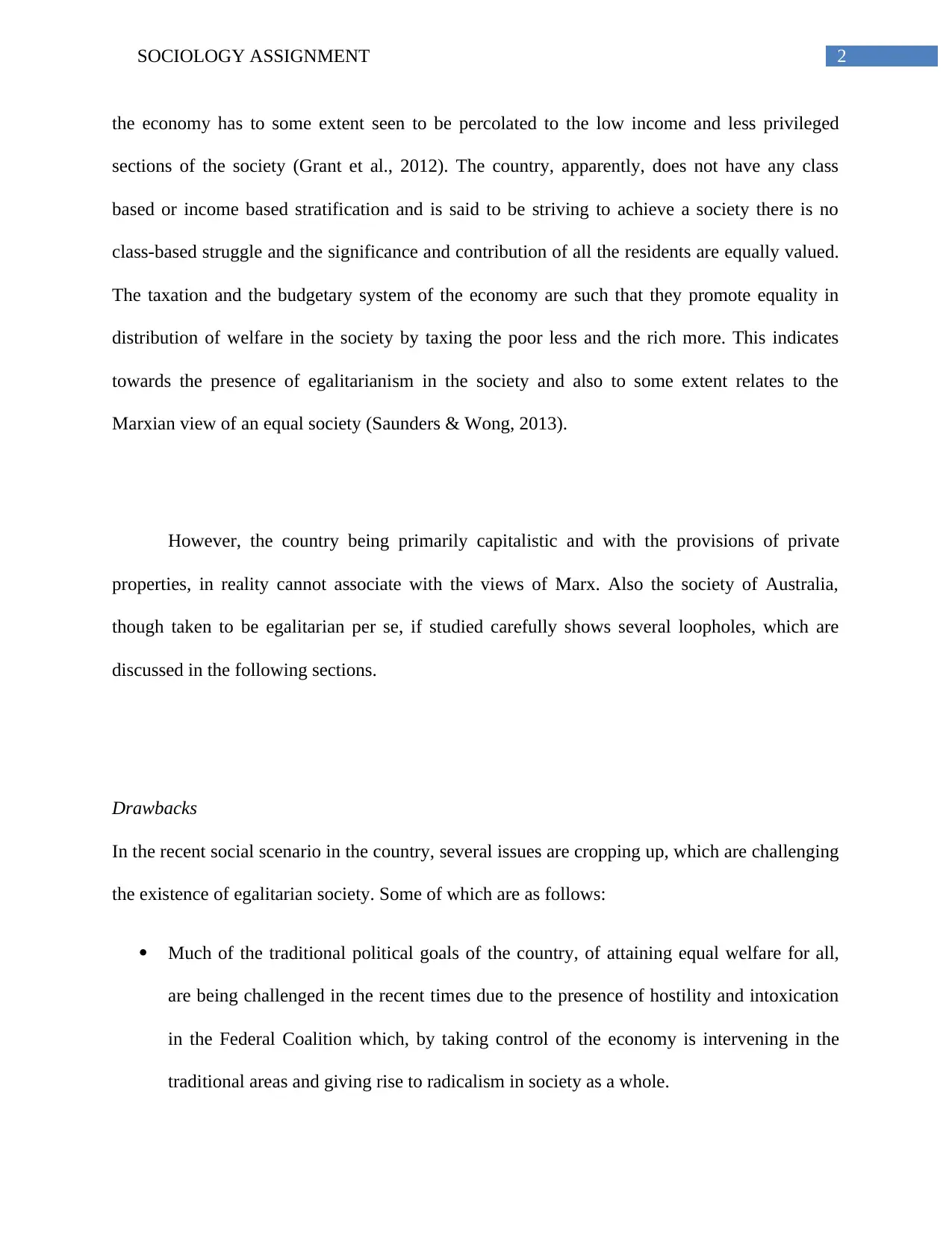
2SOCIOLOGY ASSIGNMENT
the economy has to some extent seen to be percolated to the low income and less privileged
sections of the society (Grant et al., 2012). The country, apparently, does not have any class
based or income based stratification and is said to be striving to achieve a society there is no
class-based struggle and the significance and contribution of all the residents are equally valued.
The taxation and the budgetary system of the economy are such that they promote equality in
distribution of welfare in the society by taxing the poor less and the rich more. This indicates
towards the presence of egalitarianism in the society and also to some extent relates to the
Marxian view of an equal society (Saunders & Wong, 2013).
However, the country being primarily capitalistic and with the provisions of private
properties, in reality cannot associate with the views of Marx. Also the society of Australia,
though taken to be egalitarian per se, if studied carefully shows several loopholes, which are
discussed in the following sections.
Drawbacks
In the recent social scenario in the country, several issues are cropping up, which are challenging
the existence of egalitarian society. Some of which are as follows:
Much of the traditional political goals of the country, of attaining equal welfare for all,
are being challenged in the recent times due to the presence of hostility and intoxication
in the Federal Coalition which, by taking control of the economy is intervening in the
traditional areas and giving rise to radicalism in society as a whole.
the economy has to some extent seen to be percolated to the low income and less privileged
sections of the society (Grant et al., 2012). The country, apparently, does not have any class
based or income based stratification and is said to be striving to achieve a society there is no
class-based struggle and the significance and contribution of all the residents are equally valued.
The taxation and the budgetary system of the economy are such that they promote equality in
distribution of welfare in the society by taxing the poor less and the rich more. This indicates
towards the presence of egalitarianism in the society and also to some extent relates to the
Marxian view of an equal society (Saunders & Wong, 2013).
However, the country being primarily capitalistic and with the provisions of private
properties, in reality cannot associate with the views of Marx. Also the society of Australia,
though taken to be egalitarian per se, if studied carefully shows several loopholes, which are
discussed in the following sections.
Drawbacks
In the recent social scenario in the country, several issues are cropping up, which are challenging
the existence of egalitarian society. Some of which are as follows:
Much of the traditional political goals of the country, of attaining equal welfare for all,
are being challenged in the recent times due to the presence of hostility and intoxication
in the Federal Coalition which, by taking control of the economy is intervening in the
traditional areas and giving rise to radicalism in society as a whole.
⊘ This is a preview!⊘
Do you want full access?
Subscribe today to unlock all pages.

Trusted by 1+ million students worldwide
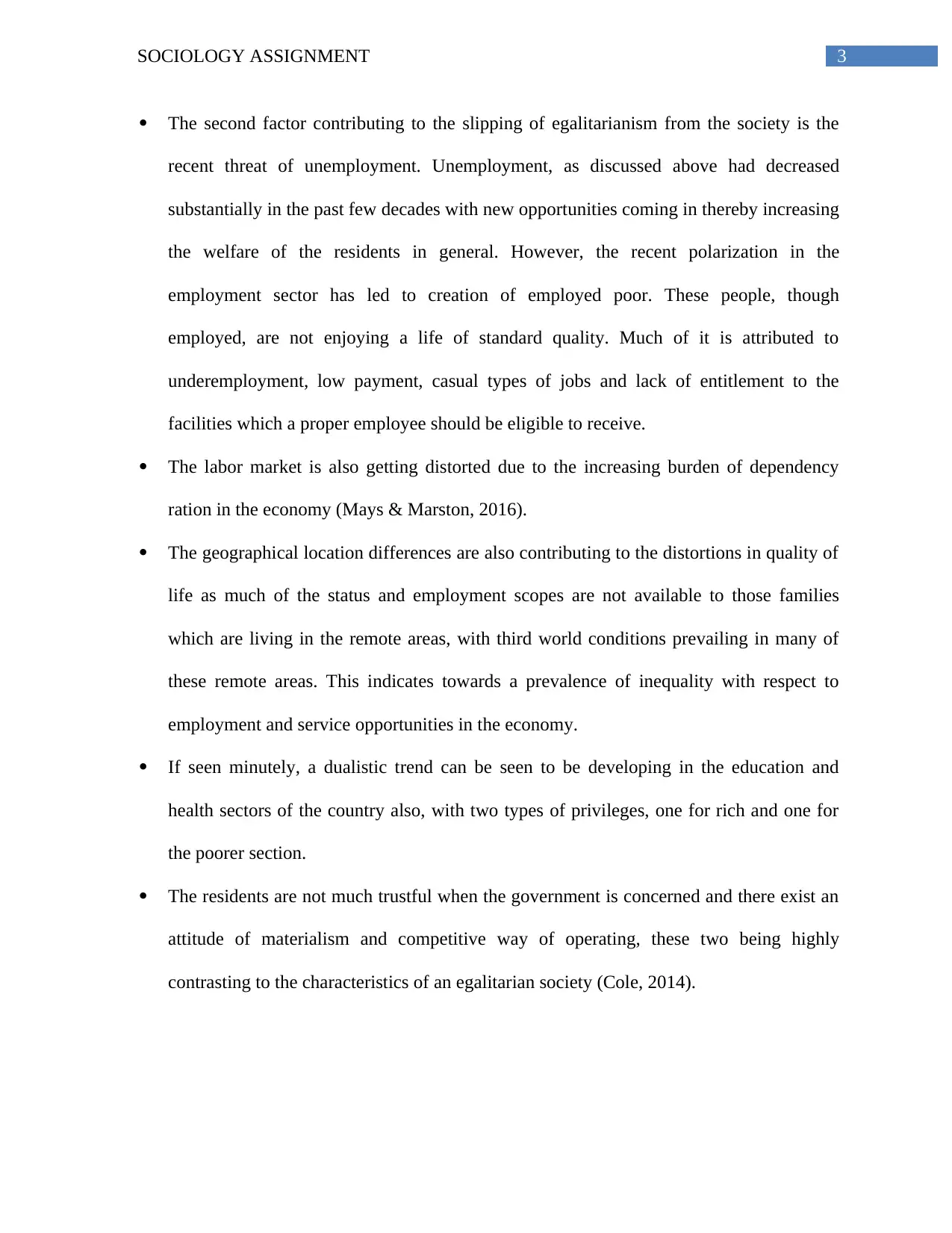
3SOCIOLOGY ASSIGNMENT
The second factor contributing to the slipping of egalitarianism from the society is the
recent threat of unemployment. Unemployment, as discussed above had decreased
substantially in the past few decades with new opportunities coming in thereby increasing
the welfare of the residents in general. However, the recent polarization in the
employment sector has led to creation of employed poor. These people, though
employed, are not enjoying a life of standard quality. Much of it is attributed to
underemployment, low payment, casual types of jobs and lack of entitlement to the
facilities which a proper employee should be eligible to receive.
The labor market is also getting distorted due to the increasing burden of dependency
ration in the economy (Mays & Marston, 2016).
The geographical location differences are also contributing to the distortions in quality of
life as much of the status and employment scopes are not available to those families
which are living in the remote areas, with third world conditions prevailing in many of
these remote areas. This indicates towards a prevalence of inequality with respect to
employment and service opportunities in the economy.
If seen minutely, a dualistic trend can be seen to be developing in the education and
health sectors of the country also, with two types of privileges, one for rich and one for
the poorer section.
The residents are not much trustful when the government is concerned and there exist an
attitude of materialism and competitive way of operating, these two being highly
contrasting to the characteristics of an egalitarian society (Cole, 2014).
The second factor contributing to the slipping of egalitarianism from the society is the
recent threat of unemployment. Unemployment, as discussed above had decreased
substantially in the past few decades with new opportunities coming in thereby increasing
the welfare of the residents in general. However, the recent polarization in the
employment sector has led to creation of employed poor. These people, though
employed, are not enjoying a life of standard quality. Much of it is attributed to
underemployment, low payment, casual types of jobs and lack of entitlement to the
facilities which a proper employee should be eligible to receive.
The labor market is also getting distorted due to the increasing burden of dependency
ration in the economy (Mays & Marston, 2016).
The geographical location differences are also contributing to the distortions in quality of
life as much of the status and employment scopes are not available to those families
which are living in the remote areas, with third world conditions prevailing in many of
these remote areas. This indicates towards a prevalence of inequality with respect to
employment and service opportunities in the economy.
If seen minutely, a dualistic trend can be seen to be developing in the education and
health sectors of the country also, with two types of privileges, one for rich and one for
the poorer section.
The residents are not much trustful when the government is concerned and there exist an
attitude of materialism and competitive way of operating, these two being highly
contrasting to the characteristics of an egalitarian society (Cole, 2014).
Paraphrase This Document
Need a fresh take? Get an instant paraphrase of this document with our AI Paraphraser
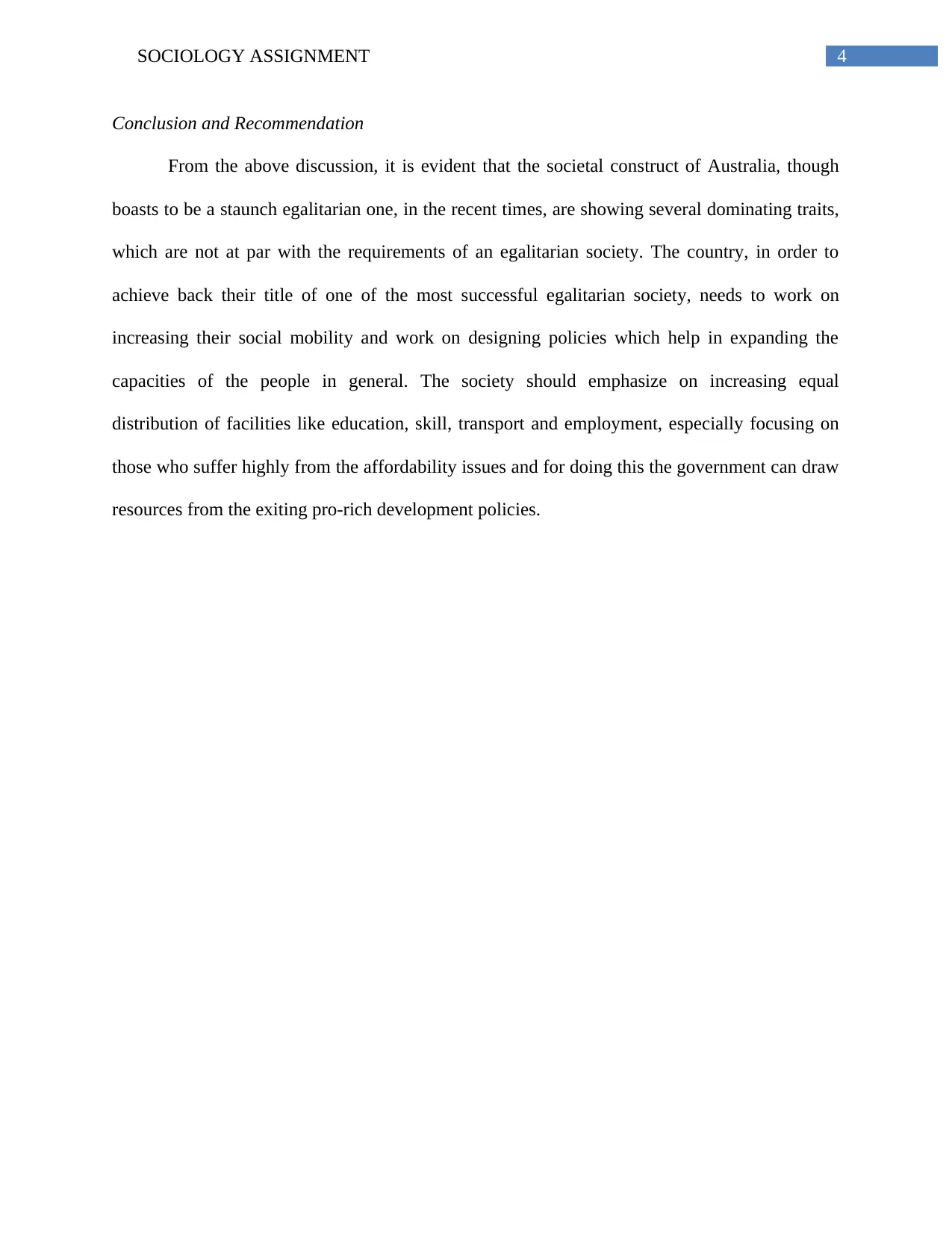
4SOCIOLOGY ASSIGNMENT
Conclusion and Recommendation
From the above discussion, it is evident that the societal construct of Australia, though
boasts to be a staunch egalitarian one, in the recent times, are showing several dominating traits,
which are not at par with the requirements of an egalitarian society. The country, in order to
achieve back their title of one of the most successful egalitarian society, needs to work on
increasing their social mobility and work on designing policies which help in expanding the
capacities of the people in general. The society should emphasize on increasing equal
distribution of facilities like education, skill, transport and employment, especially focusing on
those who suffer highly from the affordability issues and for doing this the government can draw
resources from the exiting pro-rich development policies.
Conclusion and Recommendation
From the above discussion, it is evident that the societal construct of Australia, though
boasts to be a staunch egalitarian one, in the recent times, are showing several dominating traits,
which are not at par with the requirements of an egalitarian society. The country, in order to
achieve back their title of one of the most successful egalitarian society, needs to work on
increasing their social mobility and work on designing policies which help in expanding the
capacities of the people in general. The society should emphasize on increasing equal
distribution of facilities like education, skill, transport and employment, especially focusing on
those who suffer highly from the affordability issues and for doing this the government can draw
resources from the exiting pro-rich development policies.
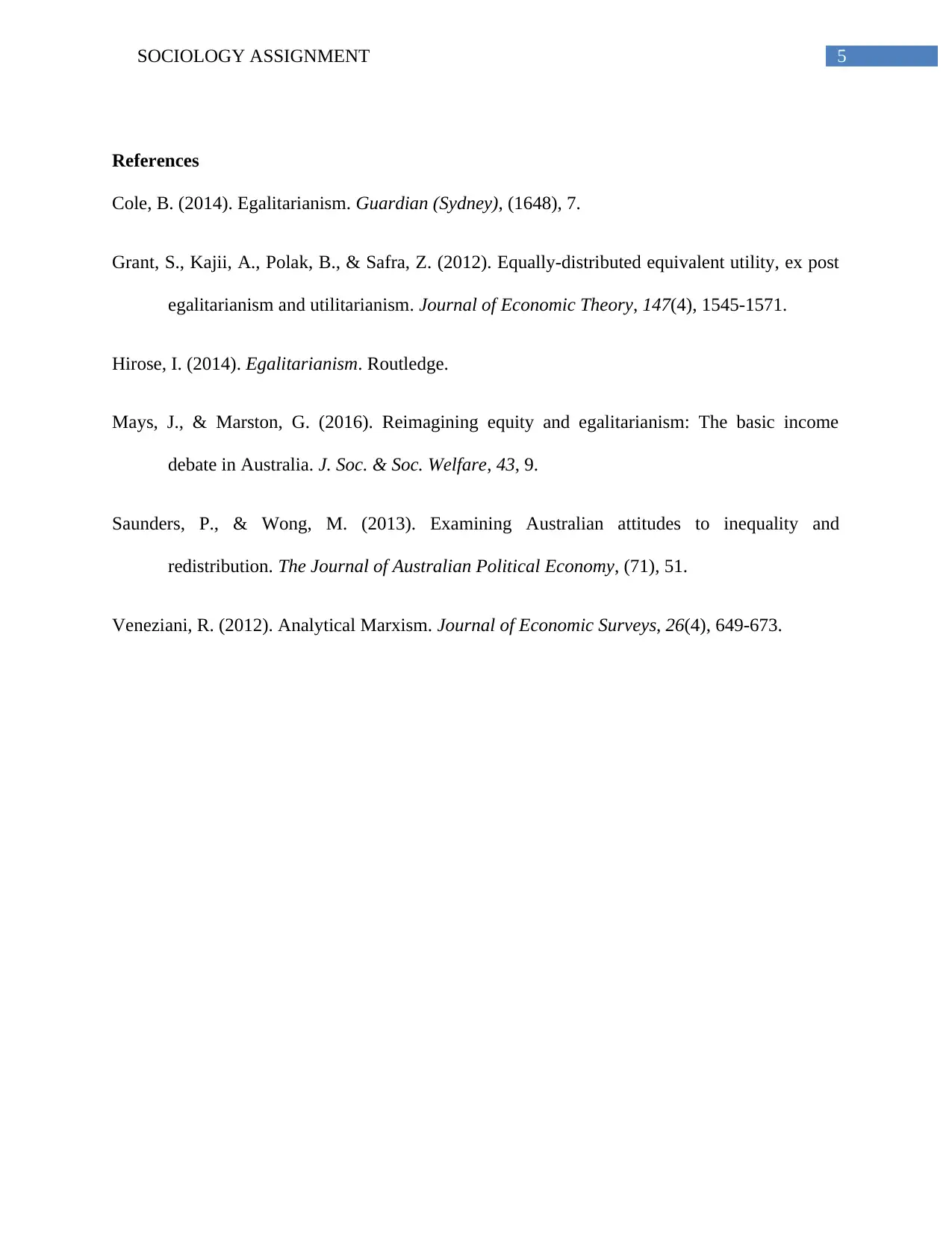
5SOCIOLOGY ASSIGNMENT
References
Cole, B. (2014). Egalitarianism. Guardian (Sydney), (1648), 7.
Grant, S., Kajii, A., Polak, B., & Safra, Z. (2012). Equally-distributed equivalent utility, ex post
egalitarianism and utilitarianism. Journal of Economic Theory, 147(4), 1545-1571.
Hirose, I. (2014). Egalitarianism. Routledge.
Mays, J., & Marston, G. (2016). Reimagining equity and egalitarianism: The basic income
debate in Australia. J. Soc. & Soc. Welfare, 43, 9.
Saunders, P., & Wong, M. (2013). Examining Australian attitudes to inequality and
redistribution. The Journal of Australian Political Economy, (71), 51.
Veneziani, R. (2012). Analytical Marxism. Journal of Economic Surveys, 26(4), 649-673.
References
Cole, B. (2014). Egalitarianism. Guardian (Sydney), (1648), 7.
Grant, S., Kajii, A., Polak, B., & Safra, Z. (2012). Equally-distributed equivalent utility, ex post
egalitarianism and utilitarianism. Journal of Economic Theory, 147(4), 1545-1571.
Hirose, I. (2014). Egalitarianism. Routledge.
Mays, J., & Marston, G. (2016). Reimagining equity and egalitarianism: The basic income
debate in Australia. J. Soc. & Soc. Welfare, 43, 9.
Saunders, P., & Wong, M. (2013). Examining Australian attitudes to inequality and
redistribution. The Journal of Australian Political Economy, (71), 51.
Veneziani, R. (2012). Analytical Marxism. Journal of Economic Surveys, 26(4), 649-673.
⊘ This is a preview!⊘
Do you want full access?
Subscribe today to unlock all pages.

Trusted by 1+ million students worldwide
1 out of 6
Related Documents
Your All-in-One AI-Powered Toolkit for Academic Success.
+13062052269
info@desklib.com
Available 24*7 on WhatsApp / Email
![[object Object]](/_next/static/media/star-bottom.7253800d.svg)
Unlock your academic potential
Copyright © 2020–2025 A2Z Services. All Rights Reserved. Developed and managed by ZUCOL.



